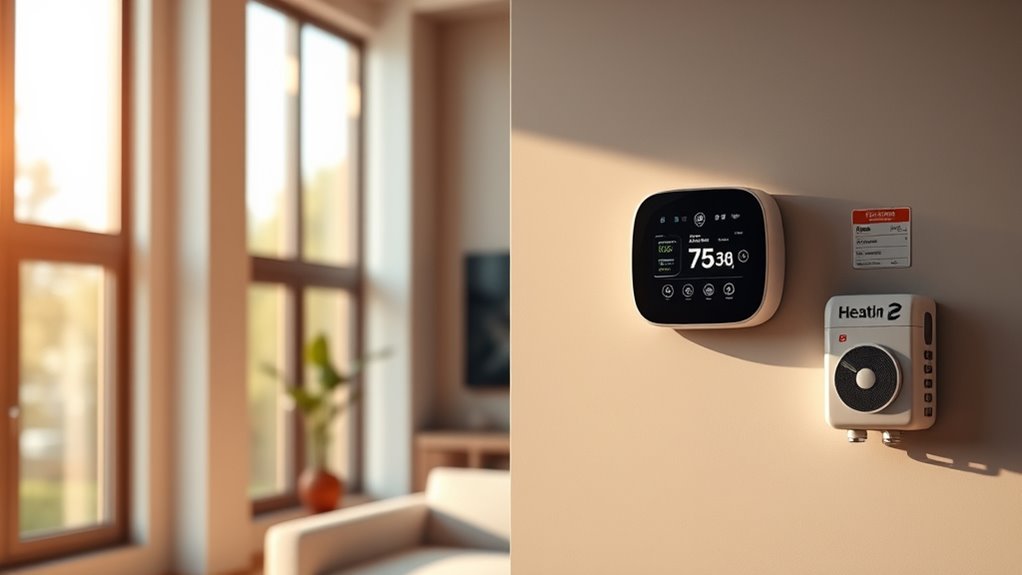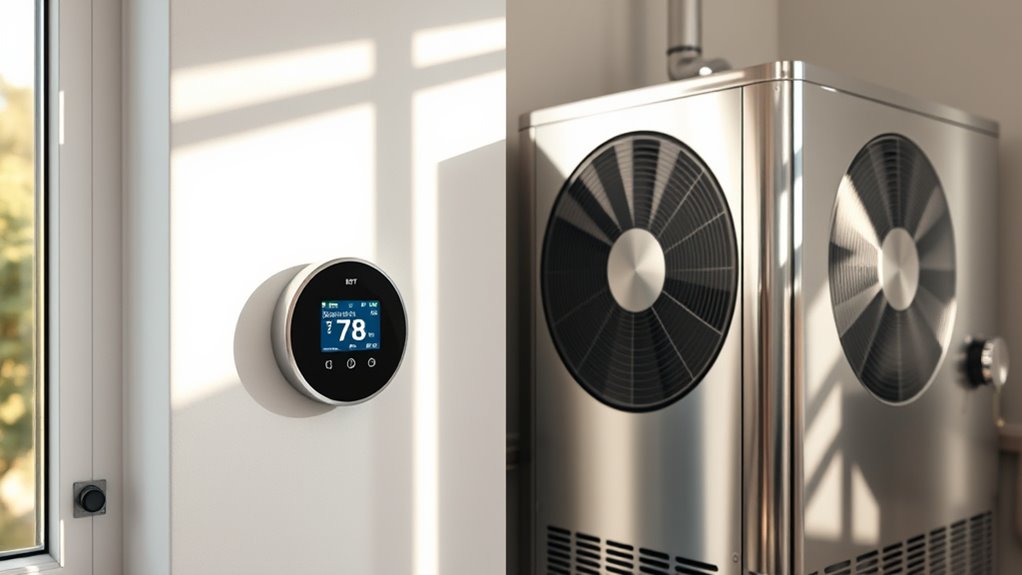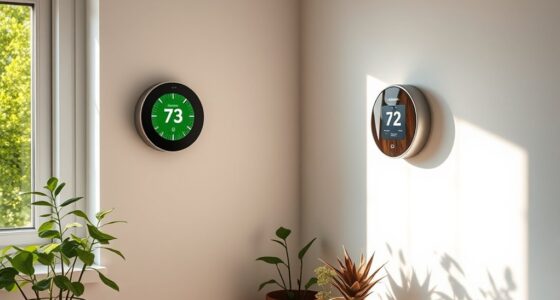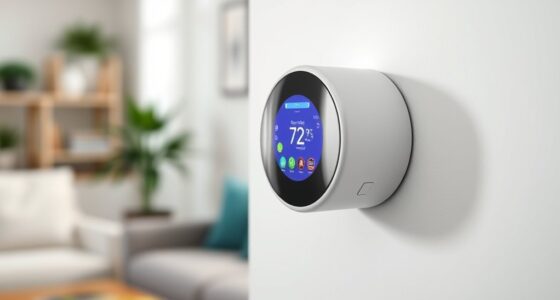Using a smart thermostat compatible with your heat pump can ensure your home’s energy efficiency. These devices provide precise control over your heating and cooling, allowing you to schedule temperatures, monitor energy use, and make adjustments remotely. Features like adaptive learning and geofencing ensure your system only runs when needed. When properly installed, a compatible smart thermostat helps reduce waste and optimize performance. Keep exploring to discover steps to get the most out of your setup.
Key Takeaways
- Ensure the smart thermostat is compatible with heat pump systems for optimal control and energy efficiency.
- Use adaptive learning and scheduling features to optimize heating and cooling based on your routines.
- Enable geofencing to adjust temperatures automatically when you leave or return home.
- Monitor energy reports to identify patterns and opportunities for reducing energy consumption.
- Proper installation and configuration ensure precise control over heat pump functions, maximizing efficiency.

Smart thermostats have revolutionized home heating by giving you greater control and the ability to optimize energy use, especially when paired with heat pumps. These devices come equipped with a variety of smart thermostat features that make managing your climate more intuitive and efficient. From learning your schedule to adjusting settings remotely via mobile apps, these features help you save energy without sacrificing comfort. When choosing a smart thermostat, it’s essential to ensure heat pump compatibility. Not all smart thermostats work seamlessly with heat pumps, so verifying compatibility guarantees you can access the full potential of your heating system.
One of the standout smart thermostat features is its ability to adapt to your routines. Many models learn your preferred temperatures and schedules over time, automatically adjusting to maintain comfort while avoiding unnecessary energy consumption. This intelligent learning capability means you won’t have to manually set temperatures every day, and the system can optimize operation based on your habits. Additionally, many thermostats offer geofencing, which detects when you’re leaving or returning home, adjusting settings accordingly to conserve energy when no one’s around or to warm the house up before you arrive.
Heat pump compatibility is essential because it determines how effectively your smart thermostat can control your heating system. Heat pumps operate differently than traditional furnaces, and some thermostats are designed specifically to manage their unique functions—such as defrost cycles or maintaining ideal refrigerant pressure. When your smart thermostat is compatible with your heat pump, it can better control heating and cooling, ensuring more precise temperature regulation and higher efficiency. Compatibility also guarantees that advanced features like multi-stage heating or auxiliary heat control work smoothly, preventing energy waste and system strain.
Installation is another aspect where heat pump compatibility plays a significant role. If your thermostat isn’t compatible, you might face issues like inaccurate temperature readings or limited control over your heat pump’s functions. Compatible smart thermostats often come with detailed wiring instructions tailored for heat pump systems, making installation straightforward. Once installed, you’ll benefit from real-time data, energy reports, and remote access, allowing you to fine-tune your system for maximum efficiency.
Frequently Asked Questions
Can Smart Thermostats Be Used With All Heat Pump Models?
Most smart thermostats are compatible with a wide range of heat pump models, but you should verify compatibility questions before installation. Some older or specialized heat pumps might need specific wiring or features that aren’t supported by all smart thermostats. To guarantee a smooth setup, review your heat pump’s specifications and follow installation considerations carefully. This way, you’ll maximize efficiency and control your system effectively.
How Do Smart Thermostats Impact Long-Term Energy Savings?
Smart thermostats considerably impact your long-term energy savings by reducing energy consumption and enhancing user convenience. You might think they’re complex, but they’re easy to program and adapt to your schedule. This means you won’t waste energy heating or cooling when it’s unnecessary, saving you money over time. Plus, their remote control features let you adjust settings anytime, ensuring your heat pump runs efficiently and keeps your home comfortable effortlessly.
Are There Specific Features to Look for in a Smart Thermostat for Heat Pumps?
Look for a smart thermostat that offers learning compatibility, so it adapts to your schedule and preferences, optimizing your heat pump’s performance. Energy monitoring features are essential, helping you track usage and identify savings opportunities. Choose a model with easy integration with heat pumps, user-friendly controls, and customizable settings. These features guarantee your system runs efficiently, saving energy and reducing costs over time.
Do Smart Thermostats Require Professional Installation for Heat Pumps?
Is it worth risking compatibility concerns? Generally, you’ll want professional installation for smart thermostats with heat pumps. They guarantee proper setup, avoid wiring issues, and confirm the device’s compatibility with your system. While some models claim DIY-friendly installation, heat pump setups can be intricate. A professional ensures peak performance, saves you time, and prevents costly mistakes, giving you peace of mind that your system operates efficiently and safely.
Can Smart Thermostats Help Extend the Lifespan of a Heat Pump?
Smart thermostats can help extend your heat pump’s lifespan by optimizing its operation, which reduces wear and tear. They use their user interface to allow you to set efficient schedules and monitor performance easily. Additionally, their battery life guarantees consistent functionality, preventing interruptions that could strain the system. By maintaining proper settings and avoiding overuse, you help your heat pump run smoothly longer, saving you money and hassle over time.
Conclusion
By pairing your heat pump with a smart thermostat, you’ll maximize energy savings and comfort. Some might think the setup is complicated, but it’s straightforward and worth the effort. Once installed, you’ll enjoy precise control, reduced bills, and a more eco-friendly home. Don’t let concerns hold you back—embrace this smart upgrade and experience efficient, reliable heating and cooling all year round. It’s a simple step towards a smarter, more comfortable home.









